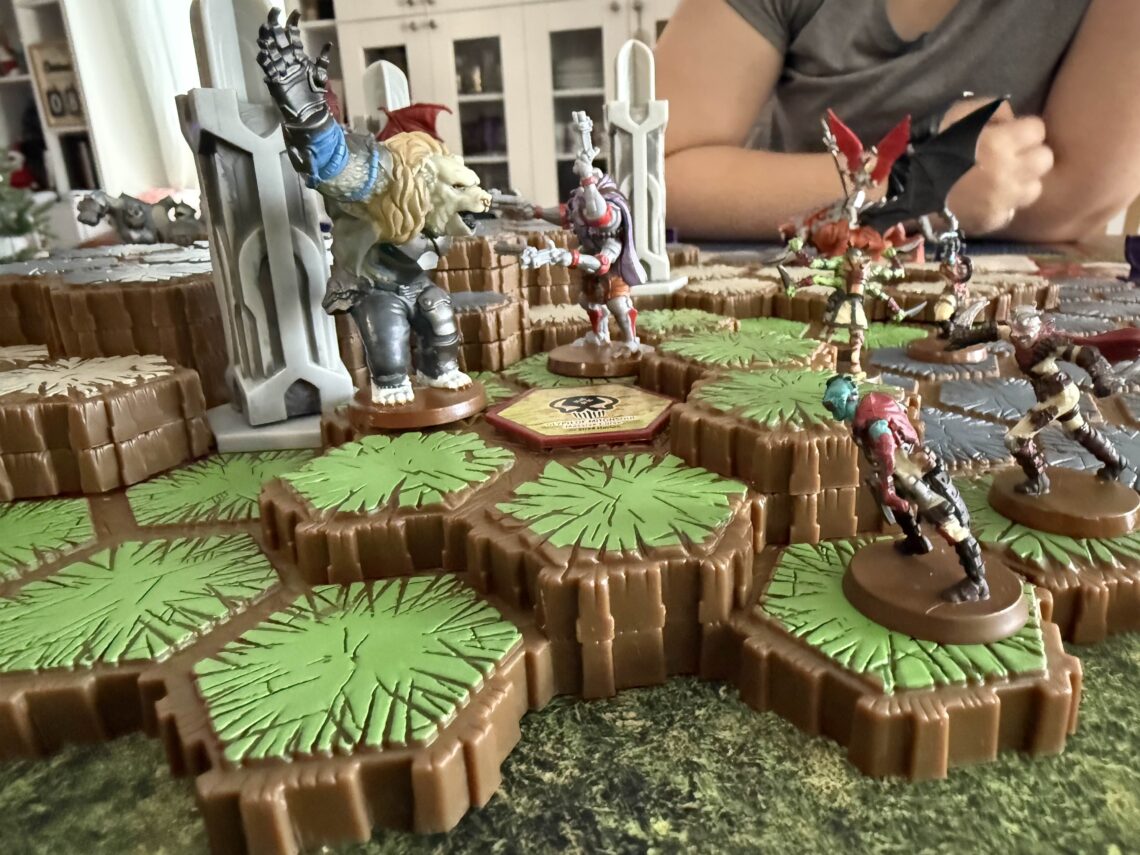Thunder Road: Vendetta
Publisher: Restoration Games
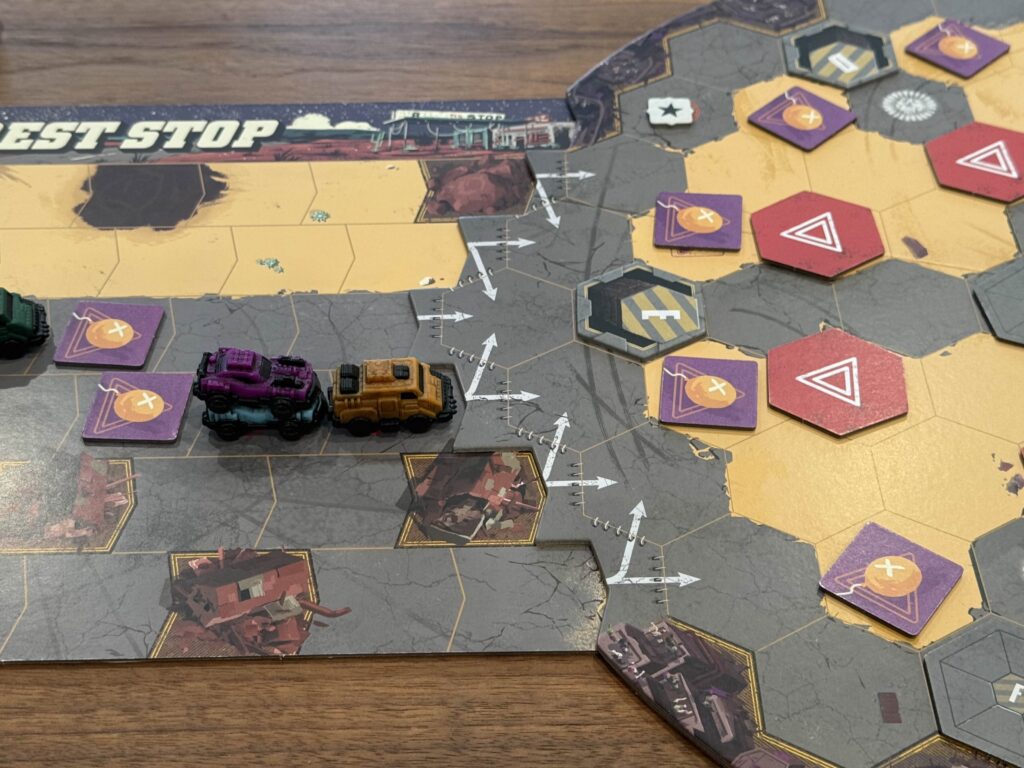
It is rare that I (Mike) play a tabletop game, decide not to purchase it, and have it haunt my thoughts for an entire year. At PAX Unplugged 2023, I made a point of visiting the Restoration Games booth for a demo of Thunder Road: Vendetta. For those unfamiliar, Restoration Games is known for giving classic games like Dark Tower and Fireball Island a contemporary makeover.
Thunder Road: Vendetta is a modern update to 1986’s Thunder Road. In the base game, players engage in a Mad Max style combat race that only reveals the finish line when one person’s vehicles are eliminated. We’ve gotten this to the table multiple times with people of all ages. It’s relatively easy to learn and teach, and there’s often a great deal of laughter as players slam into one another, send cars careening into walls, and speed away only to have it done to them a turn later.
I purchased the Maximum Chrome edition, which includes all of the expansions. These add interesting complexity (including asymmetrical Crew Leaders, a motorcycle gang, and the Big Rig, which feels like a Twisted Metal boss). Restoration Games was kind enough to give us the Carnival of Chaos expansion in our hands to try as well.
This converts the experience from a linear race into a destruction derby complete with traps, power-ups, and super weapons. Think Mario Kart’s battle mode, and you can start to see how the mayhem unfolds. You can use most of the components in the Maximum Chrome edition’s expansions (though not all of them), making this expansion an enormous value. It feels like an entirely new game, as players position themselves on the hex-based map to do as much damage as possible to earn valuable scrap (victory points).
With enormous variability in both the Maximum Chrome edition and now the Carnival of Chaos expansion, there is a ton of value here. If you like rules-light games that have tons of meaningful decisions and chaotic player interactions, this is easy to recommend.
Restoration Games provided a review copy of the Carnival of Chrome expansion.
Home
Publisher: Wet Ink Games
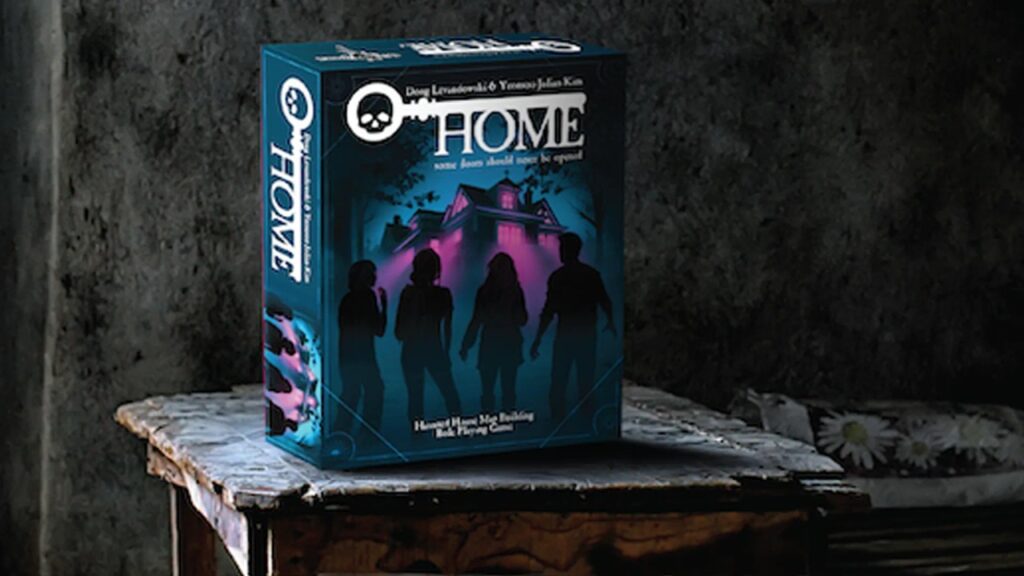
So far, there isn’t a project with Doug Levandowski’s name that we won’t immediately purchase and play. Levandowski has brought us TTRPGs like Kids on Bikes, Teens in Space, and Kids on Brooms, as well as a whole host of other delightful esoteric board games since the mid-2010s. Home is the latest in Levandowski’s projects, a team-up with Yeonsoo Julian Kim, a game designer who has written for and contributed to projects like Avatar Legends: The Roleplaying Game and Thirsty Sword Lesbians.
Home is a scene-passing game, which puts you and your gaming party in the midst of a haunted house. You and your pals will need to survive its supernatural wiles together. You roleplay as your character, of course, which is developed using one of the seven main archetypes. These archetypes allow players to explore a set of questions specific to their character, ensuring that each playthrough is as unique and expansive as the players desire. Once those questions are answered, and some of them are shared (privately or publicly, depending on instructions), you’ll set up the Haunting Deck, which guides players through the stages of the haunt.
As with any horror story, it begins mundanely with the arrival of the ensemble cast (you and your gaming party) before the cards act as inspiration for the ensuing creeps. Every player gets a chance to act as the story’s “Director”, passing the scene to the next player when finished. The cards guide that turn’s Director without dictating the actual scene itself. As the night progresses (and the haunt that you have chosen deepens), players will unlock secrets, discover terrible things about themselves and each other, and hopefully live through the night.
The twist is that as you explore this haunted house, you draw it on the reusable map using dry erase markers. You can get specific in drawing the rooms, but the game recommends only highlighting items/layout if it’s significant to the scene (keeps the map cleaner). It creates a tangible way to explore this spooky space without it needing to be entirely in the theater of the mind.
I (Manda) had a chance to sit down and play a bit of Home with two of my best friends in late 2024. All of us are experienced roleplayers so getting to the good stuff was pretty easy. By the time we were ready to call it quits for the night (because it was getting late), we had thoroughly creeped ourselves out and had a ton of fun in doing so. We played it again around the holidays in 2024 with my two besties, Mike, our husband James, and my dad. It had a different quality to it — more of an Evil Dead 2 experience than anything truly scary — and that’s testament to the quality of the game itself. Instead of being railroaded into a specific kind of experience, you can craft the tone however you want, inviting in silly spooky alongside truly terrifying.
Crossbows & Catapults
Publisher: Restoration Games
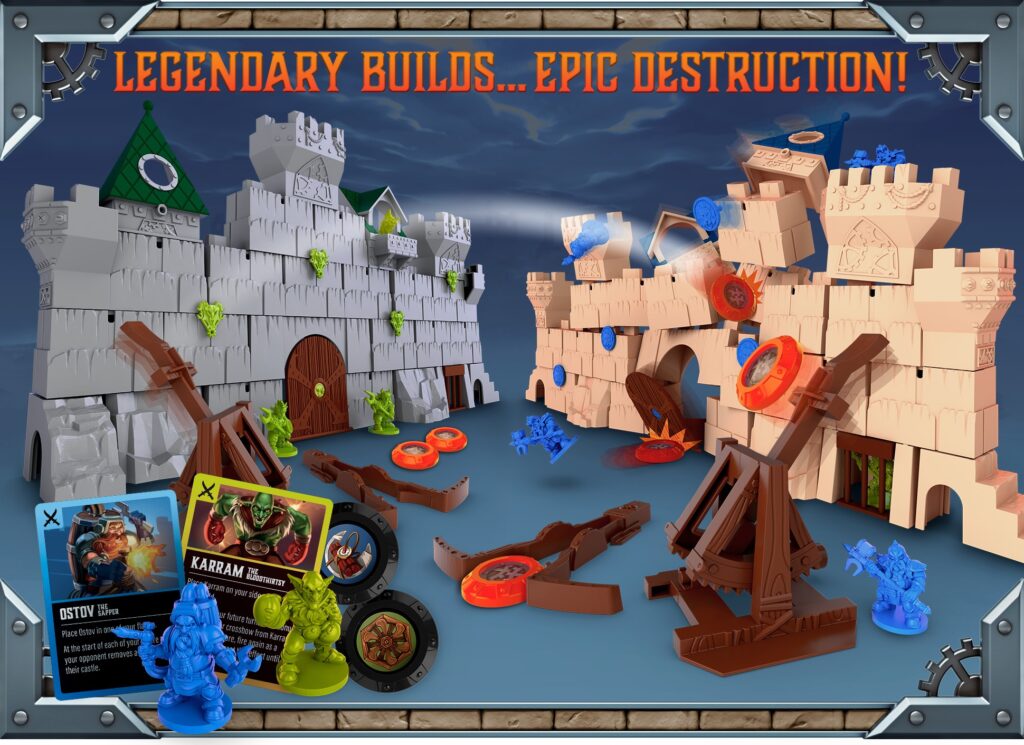
This is the second Restoration Games title on our list. Like Thunder Road: Vendetta, Crossbows & Catapults is an update of a classic game of the same name from 1983. The two have a ton in common, as both have players set up castles composed of a variety of plastic pieces to protect their soldiers from incoming projectiles.
Once the fortresses are set up, it’s time to knock ‘em down. There are two versions of the game available for purchase. Castle Battle is the mass market version and Fortress War is the hobbyist edition. Both come with enough castle pieces for two players, two crossbows, two catapults, ammunition, and a number of small miniatures.
The Fortress War box also includes optional tactics cards, more than twice as many castle pieces, cardboard decorative terrain, special ammunition, and more. You can also purchase additional castle pieces, a weapon expansion with a trebuchet and ballista, and fancy bags to keep your faction components separate.
One of the things we love about Crossbows & Catapults is that it scales in complexity nicely. This is the type of game you can easily play with smaller children with few or no rules, and they’ll get something out of it by building and knocking down castles. For children old enough to grasp simple rule sets, the basic version is extremely approachable. And for adults and children comfortable with more complexity, adding in the tactics cards gives the game much more meat.
As they do with all of their releases, Restoration Games spent time improving nearly everything about the experience. Instead of the rubber bands that were used in the original version (and tended to get weaker over time or dry out and snap), the new weapons use springs. They also have adjustment screws, so you can tune the angle of your catapult or trebuchet.
The plastic castle pieces have posts similar to Lego bricks, except they are a happy medium between snugly fitting on top of one another and sliding off at the slightest gust. They provide just enough wiggle to keep your castle together when you aren’t touching it, but easily fall off when hit with a projectile.
Crossbows & Catapults lives between toy and game, which makes it wonderful for a wide range of players. We recommend purchasing a green mat to protect your table, which has the added benefit of selling the medieval battlefield vibe.
Restoration Games provided a review copy of Crossbows & Catapults: Fortress War and the weapon expansion.
Varia
Publisher: Guildhouse Games
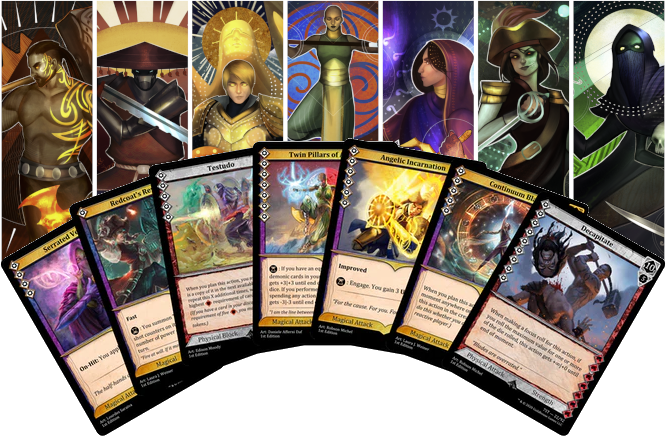
We are absolute SUCKERS for card games. Both of us have a long, storied history of playing Magic: The Gathering. Manda spent her younger years playing Vampire: The Eternal Struggle and now both of us play its spiritual successor, Vampire: The Masquerade Rivals. And while we we do still have a deep love for collectible card games (including the excellent Star Wars Unlimited), we don’t have the time to rip boosters and build decks as much as we’d like.
That’s why the advent of the living card game (LCG) and its fixed distribution rather than blind packs has been a revelation for us. You’ll hear more about our love of Arkham Horror later, but for now, we want to talk about a lesser-known entry in the genre.
Varia, by Guildhouse Games, is described as a first-person card game. Most card games which put you in the role of a commander summoning creatures to do your bidding. A Varia deck has no minions or energy cards in it. Instead, decks include attacks, defenses, and gear. During each turn, the player with priority will plan out their turn by laying out a number of attack cards, each of which represents a moment in the fight. The defending player then responds by playing cards that will mitigate the potential damage.
Each then has the chance to play fast reactions to augment their planned actions. Once both pass, the cards begin to resolve. Players resolve each moment, one at a time, with the attacking player paying for each card out of their action pool of 10. Resolving typically involves a dice roll, so there is a bit of randomness that you’ll need to account for. The strategic options available are enormous, and like a fighting game, there are some matchups that might be extremely one-sided (though this is rare in our experience).
Each Varia deck includes lore about the world and the character. We’ve been extremely impressed at how thematic the game feels, with the actions in each deck fitting the related class perfectly. There’s a bit of optional deckbuilding, if you want to switch out default equipment, but if you’re not into that, you can ignore it entirely.
We recommend starting with one of the two-player boxes or the starter set. Both include everything you’ll need to play with a friend. From there, you can pick up class decks that look interesting to you or entire sets from each “season.” The decks are all conveniently labeled with a difficulty rating, so you can tune your collection to your skill level.
If you’re interested in learning more, you can read the manual for free over at Guildhouse’s website.
HeroScape
Publisher: Renegade Games
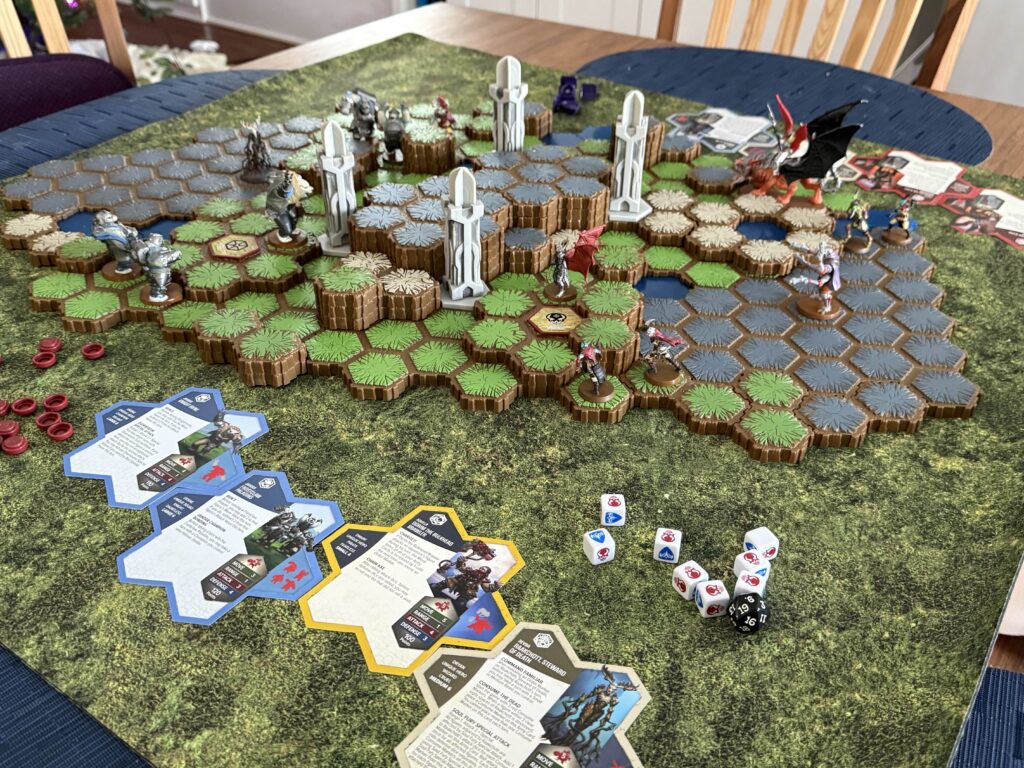
For a moment there, it didn’t look like HeroScape was going to make its triumphant return. Originally released in 2004 (with expansions rolled out through 2010), HeroScape was Milton Bradley’s entry into the tabletop wargaming space. Prior to its sunset, Hasbro-owned Wizards of the Coast acquired the brand.
The franchise was popular due to its modular, interlocking plastic terrain tiles. I’ve moved a number of times with a bin full of plastic tiles, figures, and dice. When the kids were smaller, I let them play with it all like building blocks, hoping to get it back to the table when they were older. During our last move, the bin got shoved into the back of the attic. It’s since been dusted off.
In 2022, Hasbro announced the game’s triumphant return through its crowdfunding-style HasLab program. Sadly, there wasn’t enough interest and the project was canceled and hopes were dashed. Thankfully, Renegade Games, which has developed a close relationship with Hasbro, came to the rescue.
Released in 2024, HeroScape: Age of Annihilation is a HUGE box filled with 74 tiles of varying sizes and shapes, 20 miniatures, terrain, dice, and all the rest of the components you’ll need to play. If you happen to have any of the original HeroScape products, everything is designed to work together seamlessly. The first wave also included a battle box with additional figures, a new terrain type, and tiles. Since then, Renegade has released a second wave of four products (units and new terrain) with a ton of additional expansions coming in 2025.
One of the reasons we love HeroScape is that you can build huge, fascinating maps. You could easily fill a large dining room table and play an epic game, or scale things down for a skirmish. If you’re not feeling creative, there are a number of scenarios in the boxes. Just follow the step-by-step instructions that explain how to build each map from the bottom up.
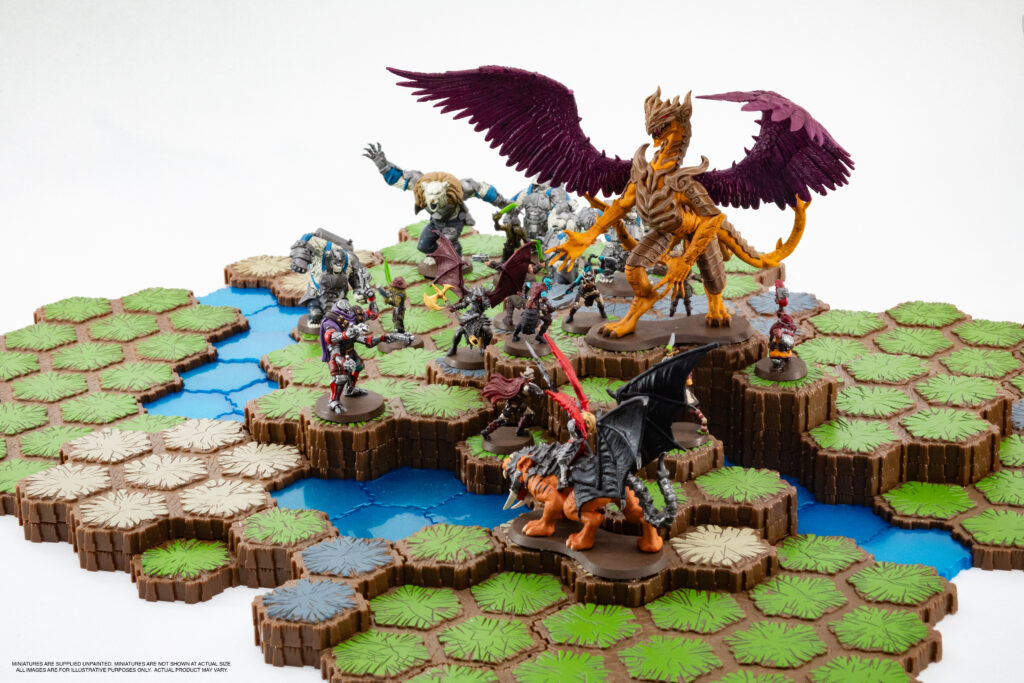
Gameplay is much more streamlined than your average tabletop wargame (like Warhammer: 40,000). Each unit has a reference card that details its stats and some lore. Movement is counted by hexes rather than with a ruler. You won’t be rolling quite as many dice as you do in 40K, but the randomness is still there. If you’ve always been interested in trying a miniatures game, but wanted to ease yourself in, HeroScape is a great place to start. And while it isn’t an inexpensive system to purchase into, you likely won’t be spending quite as much as you’d need to in order to get a Warhammer army ready for battle.
For those that love to paint, each set has an unpainted option. However, for an added charge, Renegade Games is selling sets with fully painted miniatures. Either way, starting with the Age of Annihilation Master Set or the more affordably priced Battle for the Wellspring Battle Box will get you started and give you plenty to experience. It’s a clever game that has aged well, offers tons of creativity for map builders, and scratches that competitive strategic itch.
Renegade Games provided a review copy of a number of HeroScape products.
Dungeons & Dragons: Onslaught
Publisher: WizKids Games
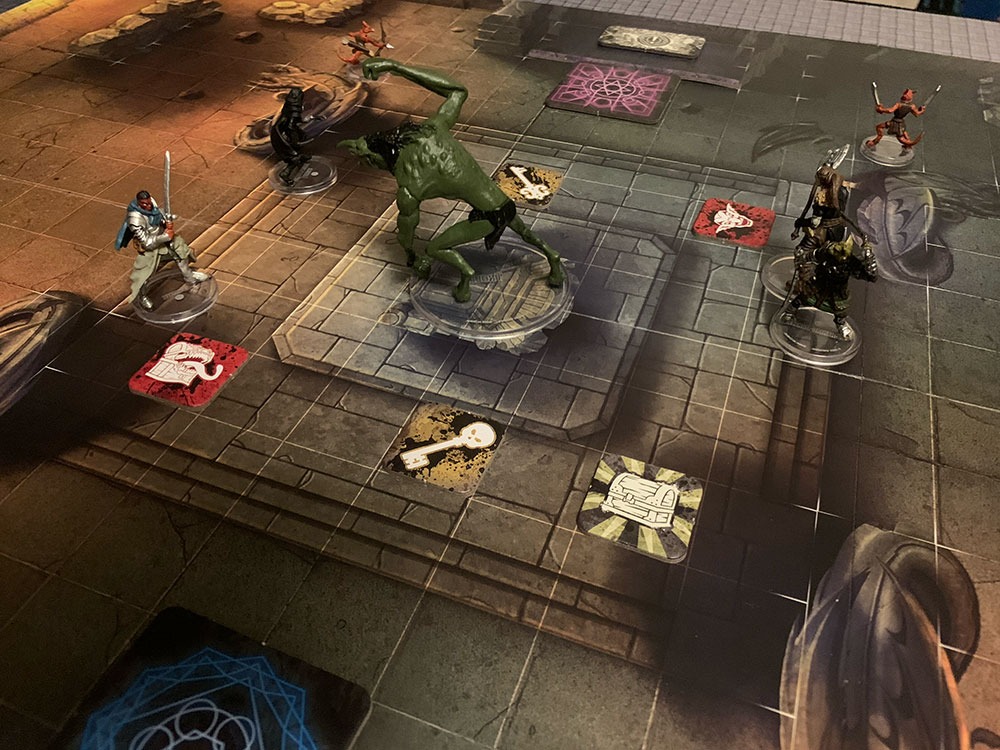
Some people play Dungeons & Dragons for the story. Others are in it for the combat. For the latter group, Dungeons & Dragons: Onslaught is a great way to get your hack-and-slash fix when you don’t have an RPG group at the ready.
There are currently two starter sets available, with the recently released Tendrils of the Lichen Lich set providing some interesting upgrades, like a modular map, new player characters and monsters, and new factions that will no doubt get built out over time. There’s plenty of D&D Fifth Edition flavor here, as well as some design cues from WizKids’ HeroClix system.
Players choose their faction, build their party, and then play out one of the many scenarios in the instruction booklet. These typically involve a race for victory points, collecting treasure, and defeating monsters that roam the map. Using a variation of D&D initiative order, players take turns activating their heroes (or villains).
On each turn, players can move, use a standard weapon attack, activate a special ability, and use consumable items looted from chests. And, yes, you’ll be rolling your trusty twenty-sided die to determine if you land a hit or whiff. As characters damage enemies, they’ll earn experience. Each level up unlocks a new ability card that can turn the tides of battle.
Dungeons & Dragons: Onslaught is for those of us who love Baldur’s Gate 3’s tactical combat. The dial-based health and ability cooldown system is implemented excellently and clearly takes inspiration from the long-running HeroClix miniatures game. As players take damage, their armor class and speed stats may change. It’s not nearly as complex as HeroClix, but it does help create some thematic investment as the battle wages on.
There are already a number of expansions, including additional faction packs of miniatures, a map and monsters pack that includes the huge Froghemoth, and smaller scenario packs. Those include monster tokens and character cards. If you want miniatures for those monsters, WizKids conveniently has a thriving business of blind-box figures. (There are retailers that sell single miniatures, though, which is how we fleshed out our collection with Illithids, Intellect Devourers, and a Beholder for The Benefactor and Grasp of the Mindflayer scenario kits.)
We’ve gotten Dungeons & Dragons: Onslaught to the table a number of times. Each battle plays out different, and the various scenarios keep the experience fresh. Add in new heroes, monsters, and maps, and you’ve got a system that has some legs.
WizKids provided a review copy of the Tendrils of the Lichen Lich starter set, which augmented our extensive Onslaught collection.
Arkham Horror LCG
Publisher: Fantasy Flight Games
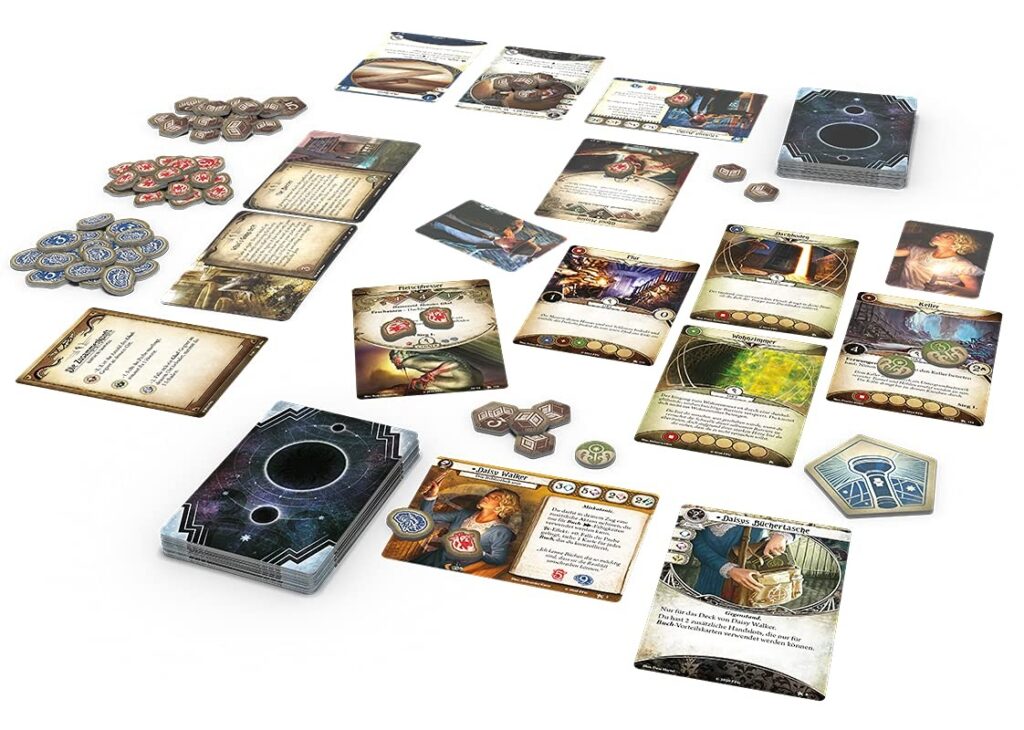
Arkham Horror has long been a cherished setting for the two of us, even though the original game is beyond cumbersome to enjoy these days. So when we discovered Arkham Horror LCG — a living card game, wherein players are able to purchase all the cards they need in installments whenever available, unlike a trading card game, which is mostly random — we knew we had a winner.
What makes Arkham Horror LCG so compelling is in its marriage of mechanics and narrative. Much like how Home is an RPG with an approachable map-making mechanic, Arkham Horror LCG is an RPG with a ton of cards. The characters (known as investigators), and therefore classes, ensure that there is a decent amount of variability and variety when playing through the various scenarios. And, much like with traditional RPGs, it’s deeply painful when a player character dies.
There are choices that need to be made that will shape the campaign, allowing players to “fail” (in that they don’t accomplish the mission’s objective) without necessarily needing to redo entire sections of the game. Now, the two of us are min-maxers in a lot of ways, especially when it comes to crafting a story, which means that we often redo missions that we were unsuccessful in.
So, y’know, there was quite a bit of “OH NO” before deciding to make the choice to restart a scenario because we didn’t want to accept defeat. (Well, we didn’t want to accept the defeat conditions in the scenario if we wanted to move on.)
Now, Arkham Horror LCG can be punishingly difficult. It often ramps up very quickly as a result of player choice (or sometimes the random nature of pulling cards from a deck) and one wrong move can spell the end for an investigator. In keeping with the Arkham Horror theme, investigators can fall in one of two ways: health reaching zero (of course) and sanity reaching zero (they lose their mind). The two of us would often find new and exciting ways to get very close to death without tipping over, since we chose investigators with very opposite (and therefore complementary) skillsets.
The scenarios themselves, in addition to being punishingly difficult, use location cards to emulate that very Arkham Horror tabletop game vibe of needing to explore (and collect clues) before moving onto the next directive. For example, we had to locate a professor at Miskatonic University while trying not to attract horrors and monsters to our locations to gum up the works, which meant that we had to constantly keep moving between locations… and not stick together.
Scooby-dooby-dooooo. (Yeah, you can guess how well that worked out for us.)
In the offchance (lolsob) that we actually successfully completed a scenario (having survived the scenario’s encounter deck, full of horrors and pain), Arkham Horror LCG allows players to improve their decks using earned XP. This means that if you do particularly well in a scenario, and earn some XP, you’ll be able to pick up some new cards (or upgrade existing ones) to augment your investigator’s existing skills, tools, and allies.
But even with the right deck, the right investigators, and a hell of a lot of luck, Arkham Horror LCG will make you suffer for playing, even if you think you’re doing everything right. At least it hurts so good.
